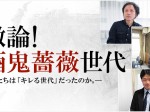日本との貿易交渉に関する政府高官によるプレスへの背景説明(仮訳)
- 2014/5/12
- 政治, 経済
- 27 comments
THE WHITE HOUSE
Office of the Press Secretary
________________________________________________________________________________________________
For Immediate Release April 25, 2014
BACKGROUND PRESS BRIEFING
BY SENIOR ADMINISTRATION OFFICIAL
ON TRADE TALKS WITH JAPAN
Aboard Air Force One
En Route Seoul, Republic of Korea
11:04 A.M. KST
MR. CARNEY: Here to talk to you about negotiations in Japan and broadly on TPP, I turn it over to a senior administration official.
SENIOR ADMINISTRATION OFFICIAL: So this was a very important couple of days for TPP. We worked more or less around the clock and the President was also very deeply involved in reaching a breakthrough on the market access discussions between the U.S. and Japan — I can talk a little bit about how that fits into the rest of TPP — which is a critical part of getting TPP done overall.
And what we were able to do this week that we’ve been trying to do for some time is really identify the pathway for the resolution of the major market access issues which were agriculture and autos. And we’ve had a series of discussions and rounds with the Japanese for several weeks, back and forth, in Tokyo and in Washington, elsewhere, but with this trip and the President’s direct involvement with the Prime Minister pursuing the issues, talking about the importance, talking about specific issues as well as the overall importance of reaching this pathway with Japan as a key part of spurring on the momentum of the TPP talks overall.
And we felt as though what we achieved here this week really is a key milestone in that regard and we do think that it will now add additional momentum and impetus to the overall TPP negotiations and position the U.S. and Japan to be working together leading towards the completion of TPP overall.
Q So can you be a little more specific about what you actually agreed to here?
SENIOR ADMINISTRATION OFFICIAL: So our focus was really on, as I said, on agriculture and on autos. In agriculture, there are a number of different products. We focused on beef, pork, dairy, but also wheat, sugar, rice. These are the six sensitive products, the six sanctuary products that —
Q It’s beef, pork, dairy —
SENIOR ADMINISTRATION OFFICIAL: Beef, pork, dairy, wheat, rice, sugar — these are the sanctuary products that the Prime Minister identified and they’re also products where we have strong market access interests, where our farmers and ranchers are able to export their product. There’s a demand for high-quality American product, and this is one of our main goals at TPP, was to help open these markets for our products. So we focused on the ag side on those issues.
And in each of these areas, we took the talks to different levels, but the overall outcome was in a number of the products we were able to identify what the path is going to be towards the ultimate resolution. When I say that it means there are various factors that go into market access agreement — the length of time over which a market access barrier might be reduced, which barriers are eliminated and which barriers are reduced and what the relationship is between them, how the market access is structured. And we went through each one of these products and oftentimes line by line of the tariffs to determine what was the most robust outcome in terms of opening markets for U.S. exports, and to do so in a way where we could secure Japan’s agreement.
And this is a market, just taking agriculture — I’m happy to talk about autos as well, but the agricultural market is one that’s been closed fundamentally in Japan for 60 years. And TPP held out the promise of opening that market and these talks today and yesterday were a critical part of doing that.
Q So, in other words, basically, to give us a little more concrete sense, are you saying that, for example, you have a parameter for a tariff being reduced whereas you now know it will be between X percent and Y percent, and that’s kind of what you’re describing as the pathway?
SENIOR ADMINISTRATION OFFICIAL: I think that’s right. I think parameter is a good way of thinking about it. There are these parameters and there are tradeoffs among parameters. The deeper the cut in the tariff, the longer time it may take to get there. And so we have a sense of what the packages might be and what the pathway forward is to us resolving this.
Q But the Japanese Trade Minister said that there were still gaps although they had been narrowed. Is that an accurate assessment?
SENIOR ADMINISTRATION OFFICIAL: I think what’s accurate is there are still negotiations to be had. There are details to be worked out and there are — some products are further along than other products, and so there’s still very much work to be done, and we’re going to continue that work.
But I think we both felt — Minister Amari and myself and, more importantly, the President and Prime Minister Abe felt that on the basis of this breakthrough or the basis of what we were able to produce over the last couple of days that we really do have a breakthrough in our bilateral negotiations. And the reason why that’s critical — it’s critical for a number of reasons.
One is it’s important in and of its own right, because we want access to Japan’s market, the third largest market in the world, and a great opportunity for American exports and therefore American jobs. But also within the context of TPP, much of the rest of the market access negotiations have been waiting for the U.S. and Japan to have a breakthrough and now that we have that, we expect that that will give momentum to other bilateral market access negotiations.
And that, in turn, is critical because for the TPP countries to agree on the rules — TPP is really two negotiations. One is a set of rules, like intellectual property rights, state-owned enterprises, things of that sort, and the other is our market access. For the other countries to agree on a set of rules, they want to know what they’re getting out of the agreement and that’s the market access piece.
So we’ve been making very good progress on the rules. In December and in February we had ministerials where we identified potential landing zones and then agreed on a series of landing zones for various rules. But to reach closure on the rules, we needed to reach a breakthrough on market access. And the meeting here is the beginning of that process, because all the other countries are looking to the U.S. and Japan to solve their market access issues before they can resolve their own.
Q Would you say that the Japanese government has agreed to drop the notion of sanctuaries for these six sectors?
SENIOR ADMINISTRATION OFFICIAL: I’d say that these are sensitive sectors for them and what we do in TPP in these sectors needs to take into account their sensitivities, but at the same time, needs to take into account the requirements of ambition for TPP as a whole and the need to create new, meaningful market access.
Q Do you have an agreement? The Japanese say, no, it’s not an agreement, that there are — gaps were narrowed, but that was all.
SENIOR ADMINISTRATION OFFICIAL: No, I think just sort of to build on my answer to Mark’s question, there still are negotiations to be done. The way I would characterize it is we have a breakthrough. We have a breakthrough, we have a pathway toward the resolution of these issues. And this is a key milestone because of the linkage to other market access negotiations and ultimate to the closure of the rules negotiations.
Q But with respect, I mean, in covering trade talks, which I’ve done in the past, until you get that final line-by-line agreement on tariff levels — to say that you have a breakthrough I’m not sure I understand. What’s to stop the Japanese from telling you a month from now, you know what, we’re not going to go to that last 2.5 percent?
SENIOR ADMINISTRATION OFFICIAL: Again, we went in many respects line by line of where we thought potential resolution, a pathway towards resolution would be. As you know covering trade negotiations, nothing is agreed to until everything is agreed to. And so when we say is there an agreement, the agreement comes on the very last day of the negotiation when you have a comprehensive package. That’s not where we are today. Where we are is at that moment where we see how we’re going to achieve resolution potentially of these key market access issues that will help unlock other negotiations.
Q (Inaudible) — element that the Japanese from the beginning here, the expanded time window for tariff cuts I’m trying to figure out what do they feel — what are they getting out of this, out of the breakthrough?
SENIOR ADMINISTRATION OFFICIAL: It’s a combination of different things. As I mentioned, there’s the element of time, which is staging. There’s what the ultimate end point is: Is the tariff eliminated? Is it reduced? Or were there are other mechanisms to create market access? How are those structured? So there are a lot of different factors, which is why you need to literally go not just product area by product area, not just through these six areas, but literally line by line within the product areas, because some products can be treated in one way and other products require another treatment. So it’s the whole combination of these factors.
Q Do you have a timeline for resolving the gaps that remain?
SENIOR ADMINISTRATION OFFICIAL: We’re engaged in continued, ongoing negotiations while our teams, I’m sure, are reengaging on an ongoing basis. I’ll see my counterpart, I imagine — first of all, our chief negotiators will be getting together. All the TPP countries will be getting together in mid-May for another TPP chief negotiators meeting. And the TPP ministers will see each other around the APEC meetings also in mid-May.
Q And you also spoke about the President having an impact on these negotiations. Could you provide a few more details about how either he or Prime Minister Abe actually affected what happened?
SENIOR ADMINISTRATION OFFICIAL: Sure. I mean, I think this was one of the — there were several issues on this agenda that my colleagues I’m sure will talk to, but TPP was certainly one prominent issue on the bilateral agenda. It came up at the dinner the first night. It played a prominent role in the bilat the next morning. And the President had direct engagement with the Prime Minister about the importance of moving TPP ahead, the importance economically to the United States, to Japan and to the region, how it was going to drive jobs and growth in the U.S., how it’s going to support reform and revitalization in Japan and give an opportunity for the U.S. and Japan to work together to help lead — to help show leadership in the region towards the closure of an agreement around a new architecture for economic relations.
And so they talked both about the strategic and economic importance of it, but the President was also very much up to speed and engaged the Prime Minister on a number of the specific issues that then they gave direction to me and Minister Amari and to our teams about how to resolve them. And so they sent us back the first night all night, and then last night almost all night to try and get resolution.
Q You guys finished off this morning some time Do you feel like you — about what time?
Q You weren’t in this last round. Was that at the kind of technical level?
SENIOR ADMINISTRATION OFFICIAL: The vice ministers did last night at the chief cabinet — cabinet office. Mr. Amari and I had discussions at the dinner.
Q And can you just walk through what the agreement or the pathway forward on autos is?
SENIOR ADMINISTRATION OFFICIAL: A main focus on autos here — as you recall, first of all, on autos we reached an agreement with Japan prior to letting Japan join TPP about what the staging of the tariffs would be in the United States. So the phase-out of tariffs on autos and trucks would be the longest of any staging of any tariff of any product anywhere in TPP upon any two countries — and it would be back loaded and substantially longer than the staging in KORUS, in the Korea agreement.
We then set up a negotiation, a parallel negotiation, over the non-tariff measures that prevent access to Japan’s market. And those have been where our focus has been for the last several months, and again, over the last couple of days here we made meaningful progress in identifying how we’re going to move forward on those issues, and so we see that moving in parallel with the agricultural negotiations.
Q Before we left, senior administration officials were talking about kind of the third arrow. They wanted to see if the Prime Minister was serious about structural changes — almost kind of in a challenging way. Was there any reaction to that Was that a positive effect on the negotiations or a negative one?
SENIOR ADMINISTRATION OFFICIAL: Well, I think the Prime Minister talked about his economic program and the President certainly asked him about the plans for structural reform. I mean, there was discussion, for example, of the role of women in the workforce in Japan, which has been a central focus of Prime Minister Abe and he has engaged in a series of domestic reform measures. And as you recall, when he worked to have Japan join TPP, one of the rationales for having Japan join was to support the kind of structural reform that he thought was necessary to revitalize and renew Japan. So that was certainly a key theme of the discussion here. So I think that’s a key theme.
The President made clear the TPP is good for the U.S. in terms of opening markets to create jobs, for growth of the U.S. It’s good for Japan in terms of promoting renewal and revitalization of Japan. And critically, it’s an important initiative for — as the President said at the press conference yesterday — for setting the rules of the road for the fastest-growing economic region in the world.
END 11:20 A.M. KST
(訳:まつだよしこ)
コメント
この記事へのトラックバックはありません。



























この記事へのコメントはありません。